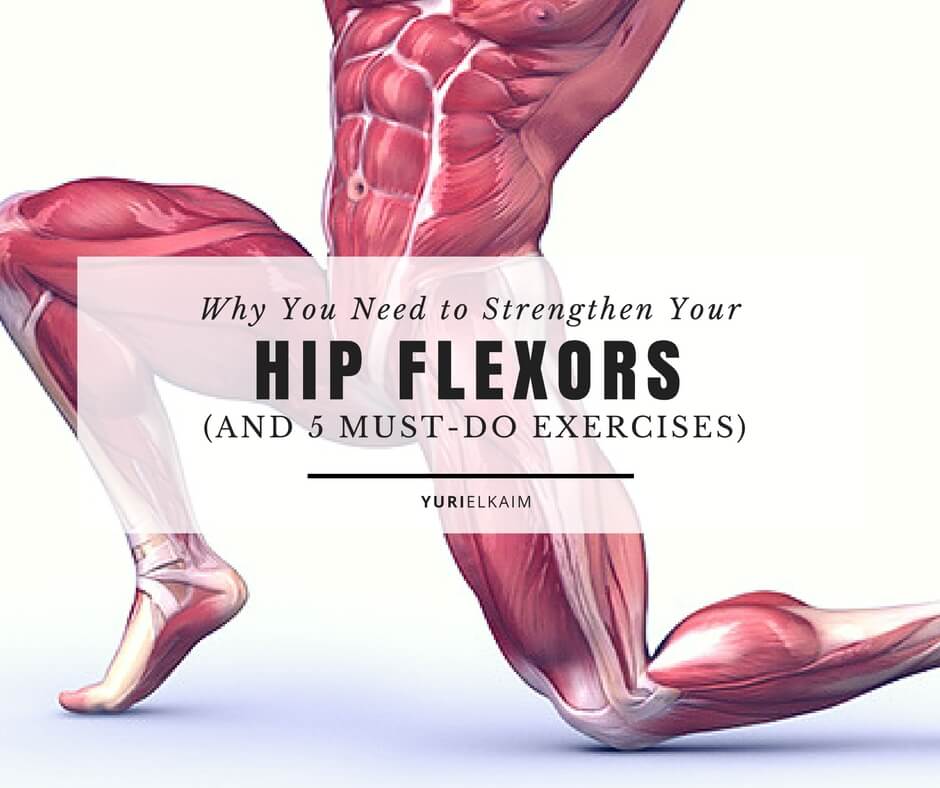
When was the last time you went to the gym just to get in a hip flexor workout?
Probably never.
But while you obviously don’t have to get in a full workout each week strictly targeting your hip flexors, you should add a few exercises to your routine to strengthen these forgotten muscles.
But first, what are the hip flexors exactly, and why should we bother with them?
The Source of All (Efficient) Movement
The hip flexors are a group of muscles around the upper and inner thighs and pelvic region that help power nearly every movement we perform. Running, jumping, and even just standing require proper flexion and stabilization of the hip flexors.
Strong hip flexors are especially important for active people and athletes, as studies have shown links between weak hip flexor stabilizing muscles and injuries (1).
Why do the hip flexors matter? Not only because most people don’t focus on strengthening their flexors, but also because every day we do things that both weaken and shorten (or tighten) them.
For example, if you sit in front of a computer or at a desk for hours a day, it both shortens and tightens the muscles in the front of the body (including your hip flexors). It also causes your shoulders to round forward, along with a forward-head posture (2).
And then if you go to the gym for a workout after sitting at the desk all day and you don’t stretch out and strengthen your hip flexors, you can compound that bad posture, creating muscle imbalances.
How does this happen? Because you’re essentially training muscles while they’re in the incorrect position.
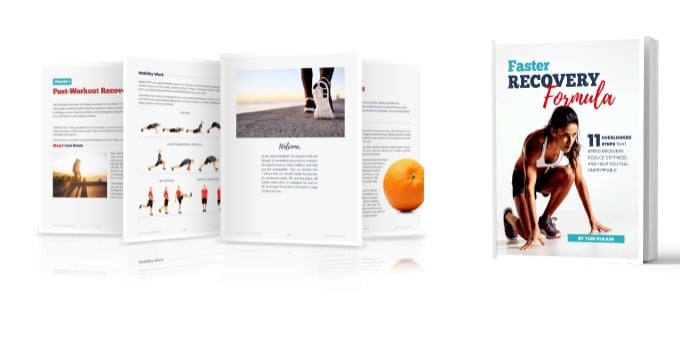
Even Athletes Must Strengthen Hip Flexors
Also, even if an individual is an athlete (say, a runner) who is moving most of the day, they can still be at risk for injuries stemming from weak hip flexors.
This is because by not doing exercises that strengthen the stabilizer muscles in the hip flexors that keep the pelvis in line, they set themselves up for improper positioning of the hips. This can then lead to hip and knee injuries by promoting incorrect foot placement while running.
That’s because the deep muscles of the hip (including the piriformis and quadratus femoris) play a critical role in hip stabilization (3).
Also, runners with iliotibial band syndrome (a common issue affecting a “band” of muscle that runs from your hip to your knee) had significant weakness in muscles of the hip (4, 5).
In short, strengthening the flexors will help avoid impact injuries in the lower body by promoting correct foot placement.
After all, the last thing you want to do is run a marathon (if you do that sort of thing) with improper form. Ouch!
Other Benefits of Strengthening Hip Flexors
Strengthening and increasing hip flexor flexibility can also increase performance. For example, one study found athletes who did hip flexor exercises as part of their routine both improved their hip flexion strength by 12.2 percent and cut their run times by as much as 9 percent (6).
Not to mention, strengthening those muscles can also improve range of motion, which is also crucial to avoid injuries (7).
Now that we’ve discovered how important your hip flexors are, let’s look at five hip flexor strengthening exercises you can introduce to your routine. Know that a few will require a stability ball.
5 Exercises to Strengthen your Hip Flexors
1. Ball Pikes
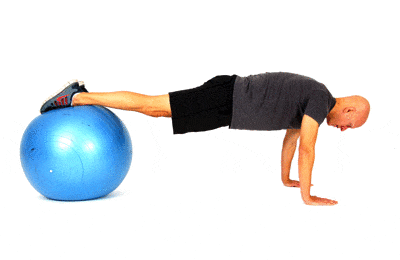
While traditionally an abdominal exercise, ball pikes also require a lot of hip strength in order to maintain balance and pull your hips into a pike position.
How to Perform Ball Pikes
- Begin in a high plank position, hands beneath your shoulders.
- Place the tops of both feet and shins on your exercise ball.
- Raise your hips toward the sky until just the very tips of your toes are touching the ball.
- Slowly lower, returning to starting position.
- Repeat for 10 to 15 reps, being sure to keep your abs engaged through the entire exercise.
2. Knee Drive Holds
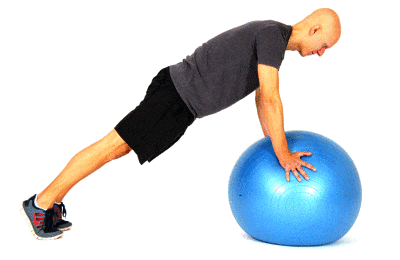
Knee drive holds engage the hip flexors in order to drive the knee to the chest, making them an excellent hip flexor strengthener. You can use either a stability ball or chair for your surface for this exercise.
How to Perform Knee Drive Holds
- Begin in an elevated pushup position on you chair or ball.
- Keeping your body in a straight line from head to toe, with your abs engaged, drive one knee in toward your chest.
- Hold your knee in place for a 2- to 3-second count.
- Return to your pushup position and repeat using the other leg.
- Repeat for 10 to 12 reps.
3. Dead Bug

The dead bug is another exercise that engages the hip flexors, this time in both an isometric hold as you extend your leg, and a contraction as you return your leg to parallel.
How to Perform the Dead Bug
- Begin lying on the floor on your back. Engaging your abs, raise your legs off the floor at a 90-degree angle.
- Now, extend and lower your right leg until its just a few inches off the floor, while simultaneously raising your left arm over your head.
- Hold for a 2-second count.
- Now, bring your extended leg and arm back to the starting position and repeat on the other side.
- Aim for 10 to 15 reps.
4. Reverse Lunge with Knee Drive
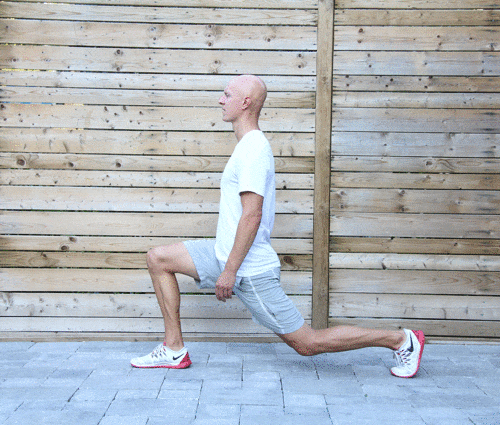
The reverse lunge with knee drive provides a dynamic stretch for the hip flexors while also strengthening them as you drive your knee toward your chest.
How to Perform the Reverse Lunge with Knee Drive
- Begin standing tall, feet hip width apart.
- Extend your right leg back behind you and lower into a lunge on your front leg.
- Now engage your glutes and push back to standing, but, instead of returning your foot to the floor, drive your knee in toward your chest.
- This knee drive should take a two second count on the raise and lower; don’t try to drive the knee too quickly.
- Return to your starting position and repeat on the other leg.
- Aim for 10 to 15 reps.
5. Ball Knee Tucks
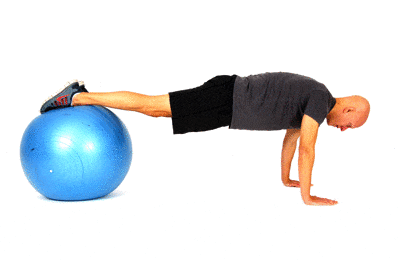
Ball knee tucks are similar to ball pikes. However, instead of piking our hips toward the sky, we’re keeping them level and using the lower abs and hip flexors to pull our knees in toward our chest.
How to Perform Ball Knee Tucks
- Begin in a pushup position, the tops of your feet and shins on your ball.
- Keeping your torso parallel to the ground, draw both your knees in toward your chest.
- Slowly return to your starting position and repeat, avoiding rocking your body back and forth as you complete the movement.
- Aim for 10 to 15 reps.
Stretching is Important Too
While all of these exercises are great for strengthening the hip flexors, it’s also important that we work on their flexibility.
That’s because tight hip flexors can actually contribute to bad posture – which causes a whole host of health problems in and of itself – but “pulling down” the upper body. This is especially true for those who spend most of their days sitting down or at a computer.
To combat tight hip flexors, try this simple stretch you can do anywhere:
- Begin standing in a lunge position, right foot forward.
- Lower your left knee to the ground and push your hips forward slightly until you feel a stretch deep in your hamstrings.
- Hold for 20 to 30 seconds, then switch legs.
Try Foam Rolling
It may also be useful to foam roll your hip flexors a couple times a week, especially if they feel tight after prolonged sitting.
Here’s a great roll for the hip flexors:

- Facing down, drop your hips onto the foam roller, fully extending the legs.
- Lean to the side you want to work on, using the toes on your opposite leg for balance.
- Repeat on the other side.
Strong Hips, Happy Body
With these exercises to strengthen hip flexors, you’ll be standing and running tall and strong in no time.
But remember, consistency is the key – it takes time to overcome chronic tightness from hours of sitting.
How to Go from “Sore” to “Supple”
Steal my 11 best workout recovery strategies to improve your flexibility, reduce stiffness, and feel good again – for FREE.
Get my Workout Recovery Formula, which will help restore and rejuvenate your body.
Download it now by clicking the banner below!
Original article and pictures take yurielkaim.com site
Комментариев нет:
Отправить комментарий